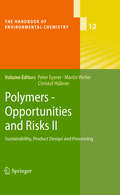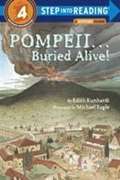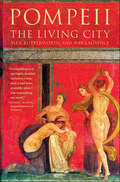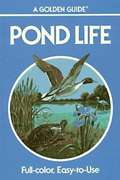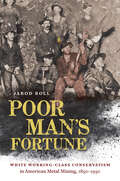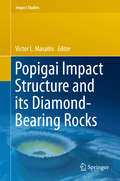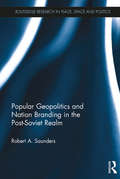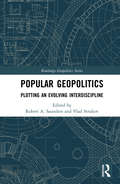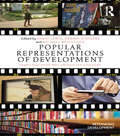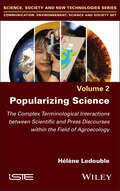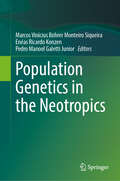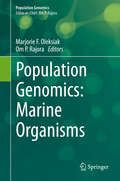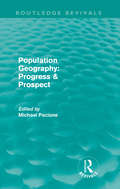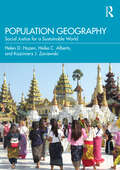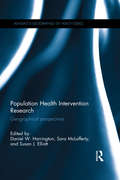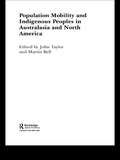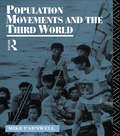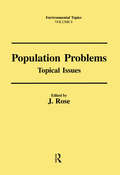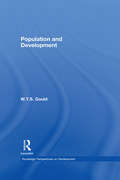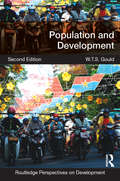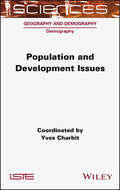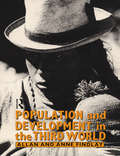- Table View
- List View
Polymers - Opportunities and Risks II
by Peter Eyerer Christof Hübner Martin WellerSince their first industrial use polymers have gained a tremendous success. The two volumes of "Polymers - Opportunities and Risks" elaborate on both their potentials and on the impact on the environment arising from their production and applications. Volume 11 "Polymers - Opportunities and Risks I: General and Environmental Aspects" is dedicated to the basics of the engineering of polymers - always with a view to possible environmental implications. Topics include: materials, processing, designing, surfaces, the utilization phase, recycling, and depositing. Volume 12 "Polymers - Opportunities and Risks II: Sustainability, Product Design and Processing" highlights raw materials and renewable polymers, sustainability, additives for manufacture and processing, melt modification, biodegradation, adhesive technologies, and solar applications. All contributions were written by leading experts with substantial practical experience in their fields. They are an invaluable source of information not only for scientists, but also for environmental managers and decision makers.
Polynomial Operator Equations in Abstract Spaces and Applications
by Ioannis K. ArgyrosPolynomial operators are a natural generalization of linear operators. Equations in such operators are the linear space analog of ordinary polynomials in one or several variables over the fields of real or complex numbers. Such equations encompass a broad spectrum of applied problems including all linear equations. Often the polynomial nature of many nonlinear problems goes unrecognized by researchers. This is more likely due to the fact that polynomial operators - unlike polynomials in a single variable - have received little attention. Consequently, this comprehensive presentation is needed, benefiting those working in the field as well as those seeking information about specific results or techniques. Polynomial Operator Equations in Abstract Spaces and Applications - an outgrowth of fifteen years of the author's research work - presents new and traditional results about polynomial equations as well as analyzes current iterative methods for their numerical solution in various general space settings.Topics include:Special cases of nonlinear operator equationsSolution of polynomial operator equations of positive integer degree nResults on global existence theorems not related with contractionsGalois theoryPolynomial integral and polynomial differential equations appearing in radiative transfer, heat transfer, neutron transport, electromechanical networks, elasticity, and other areasResults on the various Chandrasekhar equationsWeierstrass theoremMatrix representationsLagrange and Hermite interpolationBounds of polynomial equations in Banach space, Banach algebra, and Hilbert spaceThe materials discussed can be used for the following studiesAdvanced numerical analysisNumerical functional analysisFunctional analysisApproximation theoryIntegral and differential equation
Pompeii: The Living City
by Alex Butterworth Ray Laurence“Splendidly recreate[s] the bustling life of this Roman town, as well as the eruption . . . a first-rate and compelling history of an ancient city.” —Publishers WeeklyThe ash of Mt. Vesuvius preserves a living record of the complex and exhilarating society it instantly obliterated two thousand years ago. In this highly readable, lavishly illustrated book, Alex Butterworth and Ray Laurence marshal cutting-edge archaeological reconstructions and a vibrant historical tradition dating to Pliny and Tacitus; they present a richly textured portrait of a society not altogether unlike ours, composed of individuals ordinary and extraordinary who pursued commerce, politics, family and pleasure in the shadow of a killer volcano. Deeply resonant in a world still at the mercy of natural disaster, Pompeii recreates life as experienced in the city, and those frantic, awful hours in AD 79 that wiped the bustling city from the face of the earth.Please note that this ebook does not contain the photo insert that appears in the print book.“A compelling and yet highly detailed narrative. I only wish it had been available when I was researching my novel.” —Robert Harris, New York Times–bestselling author of Conclave and Pompeii“An immensely evocative, well-written and powerful portrait of what life was really like in Pompeii.” —Tom Holland, author of Dominion“Brings Pompeii startlingly alive once more.” —History Today“A vivid portrait of place and people before the cataclysms of AD 62 and 75.” —Church Times“Accessible, wide-ranging and evocative and makes surprisingly compelling reading.” —Catholic Times“For those looking to be transported back to the living city, it will be hard to resist.” —Oxford Times
Pond Ecosystems of the Indian Sundarbans: An Overview (Water Science and Technology Library #112)
by Tuhin Ghosh Sourav Das Abhra ChandaThis book aims to give a holistic overview of the pond ecosystem of Indian Sundarbans. Due to climate change, the Indian Sundarbans faces several challenges. With rising sea levels, islands are disappearing and the increasing salinity in the water and soil has severely threatened the health of mangrove forests and the quality of fresh water, soil and crops. Additionally, there have been serious disturbances to hydrological parameters in the lotic as well lentic ecosystems.This book provides new insights into lentic ecosystem-oriented research in the deltaic ecosystem of GBM-I (Ganga-Brahmaputra-Meghna, Indian Delta). The major findings from various research works are brought together, and the gaps and future possible ways forward are outlined. The book addresses the SDG 6 (Clean Water and Sanitation), SDG 13 (Climate Action) and SDG 14 (Life below Water), with a focus on the ecosystem services of ponds in the Indian Sundarbans.Despite there being many studies on riverine water, ground water and mangrove ecosystems of the Indian Sundarbans, this book offers new insights into the pond ecosystem of the Indian Sundarbans. The outcomes from this book can be utilized by researchers from the inland fisheries sector, environmental managers, professionals, and those who seek to develop ways for making pond ecosystems sustainable.
Pond Life
by George Reid Herbert Zim Sally Kaicher Tom DolanA handbook describing and illustrating some of the common animals and plants found in or near ponds, lakes, streams, and marshes.
Poor Man's Fortune: White Working-Class Conservatism in American Metal Mining, 1850–1950
by Jarod RollWhite working-class conservatives have played a decisive role in American history, particularly in their opposition to social justice movements, radical critiques of capitalism, and government help for the poor and sick. While this pattern is largely seen as a post-1960s development, Poor Man's Fortune tells a different story, excavating the long history of white working-class conservatism in the century from the Civil War to World War II. With a close study of metal miners in the Tri-State district of Kansas, Missouri, and Oklahoma, Jarod Roll reveals why successive generations of white, native-born men willingly and repeatedly opposed labor unions and government-led health and safety reforms, even during the New Deal. With painstaking research, Roll shows how the miners' choices reflected a deep-seated, durable belief that hard-working American white men could prosper under capitalism, and exposes the grim costs of this view for these men and their communities, for organized labor, and for political movements seeking a more just and secure society. Roll's story shows how American inequalities are in part the result of a white working-class conservative tradition driven by grassroots assertions of racial, gendered, and national privilege.
Poor Man's Fortune: White Working-Class Conservatism in American Metal Mining, 1850–1950
by Jarod RollWhite working-class conservatives have played a decisive role in American history, particularly in their opposition to social justice movements, radical critiques of capitalism, and government help for the poor and sick. While this pattern is largely seen as a post-1960s development, Poor Man's Fortune tells a different story, excavating the long history of white working-class conservatism in the century from the Civil War to World War II. With a close study of metal miners in the Tri-State district of Kansas, Missouri, and Oklahoma, Jarod Roll reveals why successive generations of white, native-born men willingly and repeatedly opposed labor unions and government-led health and safety reforms, even during the New Deal. With painstaking research, Roll shows how the miners' choices reflected a deep-seated, durable belief that hard-working American white men could prosper under capitalism, and exposes the grim costs of this view for these men and their communities, for organized labor, and for political movements seeking a more just and secure society. Roll's story shows how American inequalities are in part the result of a white working-class conservative tradition driven by grassroots assertions of racial, gendered, and national privilege.
Popigai Impact Structure and its Diamond-Bearing Rocks (Impact Studies)
by Victor L. MasaitisThis book highlights the most prominent research on the Popigai meteorite crater (Siberia, Russia), the 6th largest known impact structure in the world. Not only does the crater have a diameter of roughly 100 km, it is also an estimated 35.7 million years old.This monograph is an updated, extended and revised edition of the Russian-language book “Diamond-bearing Impactites of Popigai Astrobleme” and presents the most comprehensive research on the Popigai impact structure. The Popigai crater is unique in that the total amount of impact diamonds it contains exceeds all the other diamond-bearing provinces of the world.The work presented here is based on the geological mapping, core logging, geophysical survey and petrological studies of the crater, and was written by the team of geologists who first described the Popigai impact structure and its diamonds, and took part in the exploration of their deposits from 1970 to 1985.
Popular Geopolitics and Nation Branding in the Post-Soviet Realm (Routledge Research in Place, Space and Politics)
by Robert A. SaundersThis seminal book explores the complex relationship between popular geopolitics and nation branding among the Newly Independent States of Eurasia, and their combined role in shaping contemporary national image and statecraft within and beyond the region. It provides critical perspectives on international relations, nationalism, and national identity through the use of innovative approaches focusing on popular culture, new media, public diplomacy, and alternative "narrators" of the nation. By positing popular geopolitics and nation branding as contentious forces and complementary flows, the study explores the tensions and elisions between national self-image and external perceptions of the nation, and how this complex interplay has become integral to contemporary global affairs.
Popular Geopolitics: Plotting an Evolving Interdiscipline (Routledge Geopolitics Series)
by Vlad Strukov Robert A. SaundersThis book brings together scholars from across a variety of academic disciplines to assess the current state of the subfield of popular geopolitics. It provides an archaeology of the field, maps the flows of various frameworks of analysis into (and out of) popular geopolitics, and charts a course forward for the discipline. It explores the real-world implications of popular culture, with a particular focus on the evolving interdisciplinary nature of popular geopolitics alongside interrelated disciplines including media, cultural, and gender studies.
Popular Representations of Development: Insights from Novels, Films, Television and Social Media (Rethinking Development)
by David Lewis Michael Woolcock Dennis RodgersAlthough the academic study of development is well established, as is also its policy implementation, less considered are the broader, more popular understandings of development that often shape agendas and priorities, particularly in representative democracies. Through its accessible and provocative chapters, Popular Representations of Development introduces the idea that while the issue of ‘development’ – defined broadly as problems of poverty and social deprivation, and the various agencies and processes seeking to address these – is normally one that is discussed by social scientists and policy makers, it also has a wider ‘popular’ dimension. Development is something that can be understood through studying literature, films, and other non-conventional forms of representation. It is also a public issue, one that has historically been associated with musical movements such as Live Aid and increasingly features in newer media such as blogs and social networking. The book connects the effort to build a more holistic understanding of development issues with an exploration of the diverse public sphere in which popular engagement with development takes place. This book gives students of development studies, media studies and geography as well as students in the humanities engaging with global development issues a variety of perspectives from different disciplines to open up this new field for discussion.
Popularizing Science: The Complex Terminological Interactions between Scientific and Press Discourses within the Field of Agroecology
by Hélène LedoubleMedia coverage of scientific issues is a highly complex process. It involves making a specialized field accessible to the general public, without necessarily disseminating the associated scientific terms or knowledge. The terminological interactions between press discourses and scientific knowledge are presented within the field of agroecology. The analysis of textual data focuses on articles in the general press in French and English, devoted to plant protection practices using natural mechanisms (biological control). This book provides a terminological and cognitive overview of the issues involved in popularizing science in a rapidly expanding field, and of the challenges to be met in the constantly evolving environmental communication sector.
Population Genetics in the Neotropics
by Marcos Vinícius Bohrer Monteiro Siqueira Enéas Ricardo Konzen Pedro Manoel Galetti JuniorThe Neotropics hold high levels of biodiversity, figuring among the essential hotspots for conservation on Earth. Invaluable genetic resources of this biogeographic dominion must deserve attention of conservationists, as well as of breeders. This project is aimed at producing a book on population genetics directed to an audience of undergraduate and graduate students but not limited to those. In a distinct approach, we seek to develop a material devoted to population genetics in the Neotropics, contextualizing examples of several animal and plant species belonging to this highly diverse dominion. Traditional books available in the subject of population genetics commonly deal with organisms that are native to North America and Europe, while neotropical organisms are lacking in the context, so our book comes forth as an initiative towards covering that. Among several subjects, this textbook addresses studies on molecular evolution and phylogenetics, genetic structure at broad and fine spatial scales, landscape genetics, niche modeling and climate change, conservation genetics and quantitative variation and its genetic components in hotspots of biodiversity such as the Amazon, the Brazilian Savanna and the Atlantic Rain Forest. It should provide an easy going reading, with the main concepts being presented and contextualized within the Neotropical dynamics of plants and animal populations. Basic mathematical foundations of population genetics theory are provided, but no further details on deductions and advanced algebra are given, for the purpose of simplicity. The application of the studies on conservation and breeding is also addressed. The chapters were planned to be brief, describing the main concepts, processes and case studies. Invited authors were encouraged to describe examples from their own research in the Neotropics. Altogether, this project may offer students with a textbook with concepts and ideas of the Neotropical genetic diversity, bringing awareness and stimulating endeavors towards the continuance of conservation of endangered species in their environments of origin.
Population Genomics: Marine Organisms (Population Genomics)
by Om P. Rajora Marjorie F. OleksiakPopulation genomics has provided unprecedented opportunities to unravel the mysteries of marine organisms in the oceans' depths. The world's oceans, which make up 70% of our planet, encompass diverse habitats and host numerous unexplored populations and species. Population genomics studies of marine organisms are rapidly emerging and have the potential to transform our understanding of marine populations, species, and ecosystems, providing insights into how these organisms are evolving and how they respond to different stimuli and environments. This knowledge is critical for understanding the fundamental aspects of marine life, how marine organisms will respond to environmental changes, and how we can better protect and preserve marine biodiversity and resources. This book brings together leading experts in the field to address critical aspects of fundamental and applied research in marine species and share their research and insights crucial for understanding marine ecosystem diversity and function. It also discusses the challenges, opportunities and future perspectives of marine population genomics.
Population Geography: Progress And Prospects (Routledge Revivals)
by Michael PacioneFirst published in 1986, this book presents a comprehensive overview of the contemporary state of knowledge in the field of population geography. It discusses the contemporary state of the art and surveys new research developments and new thinking in the major branches of the subject. It thereby provides an introductory guide to contemporary trends and forms a reference point for future development in the subject.
Population Geography: Social Justice for a Sustainable World
by Heike C. Alberts Helen D. Hazen Kazimierz J. ZaniewskiPopulation Geography: Social Justice for a Sustainable World surveys the ways in which geographic approaches may be applied to population issues, exploring how human populations are embedded in natural and social environments. It encourages students to evaluate population issues critically, given that population topics are at the heart of many of today’s most contentious subjects. Through introducing students to different lenses of analysis (ecological, economic, and social equity), the authors ask students to consider how different perspectives can lead to different conclusions on the same issue. Identifying and tackling today’s population problems therefore requires an understanding of these diverging, and sometimes conflicting, perspectives. The text covers all the key background information critical to any book on population geography (population size, distribution, and composition; fertility, mortality, and migration; population and resources) but also pushes students to think critically about the materials they have covered using the perspectives of sustainability and social justice. In this way, students move beyond simple fact learning toward higher-level skills such as analysis, synthesis, and evaluation of materials. This textbook will be a valuable resource for students of human geography, population geography, demography, and diaspora studies.
Population Health Intervention Research: Geographical perspectives (Geographies of Health Series)
by Susan J. Elliott Daniel W. Harrington Sara McLaffertyHealth geographers are well situated for undertaking population health intervention research (PHIR), and have an opportunity to be at the forefront of this emerging area of inquiry. However, in order to advance PHIR, the scientific community needs to be innovative with its methodologies, theories, and ability to think critically about population health issues. For example, using alternatives (e.g. community-based participatory research) to traditional study designs such as the randomised control trial, health geographers can contribute in important ways to understanding the complex relationships between population health (both intended and unintended consequences), interventions and place. Representing a diverse array of health concerns ranging across chronic and infectious diseases, and research employing varied qualitative and quantitative methodologies, the contributions to this book illustrate how geographic concepts and approaches have informed the design and planning of intervention(s) and/or the evaluation of health impacts. For example, the authors argue that geographically targeting interventions to places of high-need and tailoring interventions to local place contexts are critically important for intervention success. Including an afterword by Professor Louise Potvin, this book will appeal to researchers interested in population and public/community health and epidemiology as well as health geography.
Population Mobility and Indigenous Peoples in Australasia and North America (Routledge Research in Population and Migration)
by John Taylor Martin BellThis book draws together relevant research findings to produce the first comprehensive overview of Indigenous peoples' mobility. Chapters draw from a range of disciplinary sources, and from a diversity of regions and nation-states. Within nations, mobility is the key determinant of local population change, with implications for service delivery, needs assessment, and governance. Mobility also provides a key indicator of social and economic transformation. As such, it informs both social theory and policy debate. For much of the twentieth century conventional wisdom anticipated the steady convergence of socio-demographic trends, seeing this as an inevitable concomitant of the development process. However, the patterns and trends in population movement observed in this book suggest otherwise, and provide a forceful manifestation of changing race relations in these new world settings.
Population Movements and the Third World (Routledge Introductions to Development)
by Mike ParnwellThe interrelationship between migration and development is complex. The causes of migration stem from the uneveness of the development process and the effects exert a powerful influence on the pattern and process of development. This volume explores both the concepts and facts behind the main forms of population movement in the third world today, particularly rural-urban migration. Examining the causes and consequences of migration, the author assesses the implications for planning and policy-makers.
Population Problems: Topical Issues (Environmental Topics Ser. #Vol. 8)
by J. RoseThe effects of the rapidly expanding human population on the environment and the planet's future is a matter of increasing concern and lively debate. This timely collection of essays discusses some of the most important aspects of the population growth phenomenon and offers potential solutions. Chapters analyse population dynamics, carrying capacity of the environment, water and food supply, effects on tribal societies, and the AIDS pandemic.
Population and Development
by W.T.S. GouldPopulation and Development addresses important issues at the heart of the problems of developing countries. How these countries address the common difficulties of population growth, including mortality and fertility decline, population redistribution including internal migration and urbanization, and also international migration, for both source countries and for destination countries. How and why has population change affected development – both positively and negatively? How and why has development affected population change – both growth and distribution? The book opens with an introduction, preceding the ten substantive chapters, covering some of the broader issues for population studies and development studies and the relationships between them. The first three chapters set out the main concepts and theoretical discussions on how population affects development and also how development affects population. Detailed chapters then cover each of the three main components of population change – fertility, mortality and finally migration. These are followed by chapters on the impacts of age structures, including the potential for a demographic dividend, and of the more qualitative aspects of human resource development through formal education and ICTs, with further chapters on population policies and population futures. The book incorporates illustrative text boxes and case studies on regions in Africa, the Middle East and Asia which elaborate the broader theoretical and conceptual substance of the ten major chapters. Each chapter has ‘Discussion Questions’ and ‘Sources and Further Reading’ sections, and there is an extensive integrated References section. The arguments of the book bring together a large but fairly loosely integrated literature from population studies, development studies and geography in a conceptually coordinated, empirically wide-ranging and challenging discussion. It is targeted at an audience in undergraduate courses in Geography and in Masters courses in Development Studies and Population Studies. The books succinct but erudite structure means it can be used either as a course text book, or as a basic reference on a range of current issues and likely concerns at the interface between Geography, Development Studies and Population Studies.
Population and Development
by W.T.S. GouldThe new edition of Population and Development offers an up-to-date perspective on one of the critical issues at the heart of the problems of development for all countries, and especially those that seek to implement major economic and social change: the reflexive relationships between a country’s population and its development. How does population size, distribution, age structure and skill base affect development patterns and prospects? How has global development been affected by regional population change? Retaining the structure of the well-received first edition, the book has been substantially revised and updated. The opening chapters of the book establish the theoretical and historical basis for examining the basic reflexive relationship, with exploration of the Malthusian perspective and its critics to examine how population change affects development, and exploration of the Demographic Transition Model and its critics to examine how, why and to what extent development drives population change. These are followed by empirically rich chapters on each of the main components of population change – mortality, fertility, internal and international migration, age structures and skill base – each elaborating key ideas with detailed and contrasting case studies from all regions of the developing world. There are concluding and more integrative discussions on population policies and global population futures. Bringing together Population Studies, Development Studies and Geography, the new edition of Population and Development is a key resource for undergraduate and postgraduate students across a range of programmes with specialist modules on population change. There is a large bibliography, with major new sections identifying a wide range of online resources for further study. Each chapter contains a reading guide with discussion questions. The text is enlivened by a number of case studies from around the world, most of which are new or have been substantially revised. Written by a leading international scholar in population, the book successfully integrates cutting-edge academic research with the focus and efforts of international development agencies.
Population and Development Issues
by Yves CharbitOne of the major challenges facing the world today is the interaction between demographic changes and development. Rather than the usual view that the population itself is the main problem, Population and Development Issues argues that it is just one factor among many others, such as poverty, illiteracy, poor health, unemployment, the condition of women and climate change.This book analyzes the relationships between the key demographic variables (fertility, morbidity and mortality, migration, etc.) and major development issues, notably education, employment, health, gender, social and geographical inequalities and climate concerns. Bringing together contributions from specialists across every field, it presents empirical data simply and clearly alongside theoretical reflections.
Population and Development in the Third World (Routledge Introductions to Development)
by Allan M. Findlay Anne FindlayAllan and Anne Findlay argue that a nation's human population is a vital resource in the development process. Changes in its composition - increased life expectancy combined with a falling birth rate, for example - can have profound effects upon a society. Warfare and mass migration of male workers also have long-reaching effects on those left behind. The rapid growth of Third World populations has often incorrectly been identified as the major force preventing more rapid economic development. Population pressure has been known to generate technological breakthroughs. Their final chapter examines family planning programmes, and concludes by asking who benefits most from population policies and questioning the right of developed countries to advocate family planning programmes for Third World nations.
